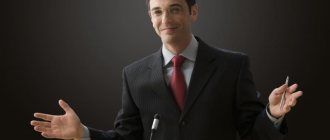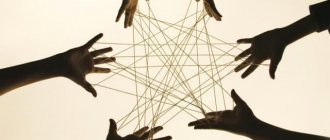Body and gesture language in psychology is what makes people understand each other without words. In another way, this is called nonverbal communication, which includes facial expressions, facial expressions, position of arms, legs, body, and gait. Today I invite you to learn how to read body language.
Interesting science will allow you to understand how your interlocutor is feeling at the moment: happy, sad, flirting, or trying to hide something. The psychology of gestures when communicating with each other brings bright colors to everyday life. Movements and facial expressions are used to express emotions, sympathy or antipathy.
Body and gesture language: psychology
The psychology of body language is the key to the secrets with which you can convey feelings and thoughts without words and hide your intentions. People without proper practice cannot control their own body movements. The signals are involuntary, and postures, gestures, and expressions of emotions through facial expressions occur impulsively and unconsciously.
The human body is a tool, and facial expressions, postures, and gestures are psychological weapons that allow you to achieve success in different areas of life. Having studied the psychology of body movements, you can “see through” a person, acting in your own interests.
I have been dividing people for a long time: by word, tone, gesture, look - into those for whom I myself will pour and those with whom I will not sit next to drink! I. Guberman
Body language can be trusted, it comes from the subconscious and cannot be faked. Facial expressions in the psychology of communication are universal. By studying body language and gestures, you can learn to recognize negative emotions, feelings, plans, understand what is on a person’s mind and what should be expected from him.
It is useful to learn to recognize body language in psychology, which will be useful in any situation: on dates, negotiations, showdowns and in other important circumstances. At the same time, you can understand whether they are misleading you or telling the truth. It would be nice to learn to control your movements so as not to expose what you need to hide.
Human psychology by behavior and gestures
Nonverbal cues: open postures of a person
How to understand body language? Let's look at poses that can be classified as “open”: straight back, relaxed body, uncrossed arms and legs in a free position, gaze directed at the face. A person with a straight back always seems confident and reliable, someone worth trusting. If your friends are sociable and like to be the center of attention, they are open and sincere.
Nonverbal messages imply productive communication. Openness poses are useful for demonstrating to people a friendly attitude towards them, sympathy for listeners, helping to establish the necessary contact in a calm atmosphere, and expressing sympathy.
Signs of openness are relaxed, free movements with a predisposition to communicate and trust. This is expressed in a slight tilt of the body to the speaker, quiet laughter, a smile and open palms.
If there are a lot of people in the company, pay attention to how each of your friends sits down. For example, if a person prefers a seat in the middle of the sofa, he is sociable and loves to be the center of attention. Anyone who can sit down in your presence with their legs tucked under them also feels confident and calm. Hands and knees pointing to the sides confirm sincerity and openness.
Nonverbal communication
Nonverbal gestures: closed human postures
What do human postures mean? People shut down when they are nervous, unsure of themselves, or incompetent to discuss something. In this case, characteristic movements involuntarily appear: clenching fists, touching hair, fiddling with keys and other objects in their hands.
Closed gestures - crossed legs and arms, tense facial muscles, when protective barriers show stress and discomfort. The psychological state and emotions are noticeable in the movements of the hands: one hand is lowered along the body, and the other grabs it.
Folded arms on the chest demonstrate a person’s desire to build protection, and others perceive this as a repulsive movement. Tables that do not allow you to sit close to each other, as well as umbrellas, bags, folders, and packages placed in front of you can be an obstacle to establishing contact.
Man's body language and gestures
Body language: what gestures can tell
People who want to hide the truth consciously control their facial expressions and movements. This is only possible with a lot of training and willpower. Knowledge of body language and gestures is needed to find out the truth and reveal lies. Sometimes you just need to be attentive during a conversation. Let's look at what gestures and body parts mean, where each is responsible for its own problem:
- eyes - emotions associated with personal relationships;
- neck - negativity and aggression;
- hands in front of you, open palms - calm and trust;
- chest - restraint, self-control;
- diaphragm - feeling of satisfaction, volitional efforts;
- stomach - a feeling of threat and danger;
- pelvic area - true and intimate feelings.
When assessing the reaction of individual parts of the body, it is necessary to pay attention to the movements as a whole. Often a person cannot control the body and it becomes easy to reveal the deception.
Human facial expressions
Most often, the main object of research is the human face. The study of basic facial expressions, such as joy, anger, fear, disgust, surprise, suffering, has developed a unit of analysis of facial expression - a facial sign. The combination of such features forms the structure of various facial expressions. Let's consider the most typical emotional states.
The first and often the main impressions of a person can be formed from observing the grimaces of his face. Enjoyment - occurs when savoring taste impressions. The most pronounced facial expressions occur in those people who have developed kinesthetic perception abilities. An inquisitive grimace (lips are pulled forward, may be slightly open or loosely closed) occurs during assessment and examination. Protest (the corners of the mouth are slightly raised, the mouth may be slightly open) is often accompanied by wide open eyes.
Under the influence of the feelings experienced by a person, coordinated contractions and relaxations of various facial structures are born, which determine the facial expression that perfectly reflects the emotions being experienced. Since it is not difficult to learn to control the state of the facial muscles, they often try to mask or even imitate the display of emotions on the face.
The sincerity of human emotions is usually indicated by symmetry in the display of feelings on the face, while the stronger the falsehood, the more the facial expressions of its right and left halves differ. Even easily recognizable facial expressions are sometimes very short-lived (fractions of a second) and often go unnoticed; To be able to intercept it, you need a lot of practice or special training. At the same time, positive emotions (joy, pleasure) are recognized more easily than negative ones (sadness, shame, disgust). A person’s lips are particularly emotional, and they are not difficult to read: for example, increased facial expressions or biting of lips, for example, indicate anxiety, and a mouth twisted to one side indicates skepticism or ridicule.
A smile on the face usually shows friendliness or a need for approval. A smile for a man is a good opportunity to show that he is in control of himself in any situation. A woman's smile is much more truthful and more often corresponds to her actual mood. Since smiles often reflect different motives, it is advisable not to rely too much on their standard interpretation: excessive smiling - the need for approval; a crooked smile is a sign of controlled nervousness; a smile with raised eyebrows - readiness to obey; smiling with lowered eyebrows - showing superiority; a smile without lifting the lower eyelids is insincerity; a smile with constant widening of the eyes without closing them is a threat. Knowing facial expressions during various emotions is useful not only for understanding others, but also for carefully practicing (usually in front of a mirror) your working imitations.
People always prefer to look at those they clearly admire, or those with whom they have close relationships, from a close distance; Women show more visual interest than men. During communication, they most often look into the partner’s eyes when they listen, and not when they speak, although, when carrying out suggestion, they sometimes use direct gaze into the eyes at the moment of speaking the dialogue. A person who looks you in the eye for noticeably less than one third of the entire communication period is either dishonest or trying to hide something; the one who openly persistently peers into your eyes, experiences increased interest in you (pupils are dilated), shows outright hostility (pupils are constricted) or strives to dominate.
Gestures and their meaning
During a conversation, a person uses nonverbal cues. Psychologists say that they are involuntary, but you can learn to control them, manage facial expressions and postures when communicating. Nonverbal signals, regardless of us, refute or complement the conversation.
Having learned to distinguish between different types of reactions, a person will understand the true emotions of the interlocutor. I propose to consider some non-verbal body signals:
- A nod of the head indicates the interlocutor’s desire to quickly complete the conversation.
- Hands in pockets - the opponent is not going to tell the truth.
- Slow nods of the head indicate interest and attention.
- A raised index finger means a desire to interrupt the conversation.
- Tapping your fingers on the table means impatience, irritation, loss of interest.
- Crossing your arms over your chest means hostility, a desire to isolate yourself from your interlocutor.
- Tapping your knuckles, fiddling with objects in your hands is a desire to distract attention and avoid negativity in your direction.
- Pulling your earlobe or touching your chin indicates fatigue and a desire to rest.
Body language can change with age and is also influenced by status, gender and personal characteristics.
Movements can convey feelings and emotions, but not deep relationships. Body language and gestures are needed to complement and enhance emotionality. People may not pay attention to their own and others' movements, but they subconsciously recognize them. Body and gesture language: psychology
| Language of the body | What does this mean |
| Straight gait | Self confidence |
| Hands folded on chest | Defense, defense |
| Hands on cheek | Reflection, evaluation |
| rub your nose | Doubt, lies |
| Rubbing hands | Anticipation |
| Hands folded behind back | Anger, fear |
| Open hands, palms visible | Sincerity, innocence |
| Nail biting | Diffidence |
| Touch your chin | Trying to make a decision |
| Tapping fingers | Impatience |
| Straighten your hair | Desire to attract attention |
| Sit cross-legged | Excellence, confidence |
| Pinching the bridge of the nose | Negative review |
| Sit with your legs apart | Openness, relaxation |
Body psychology: gestures of uncertainty and doubt
Let's consider the psychology of human behavior. A doubtful person looks away, looks out the window or past the interlocutor. Eyes with lowered eyelids may wander around the room. You need to understand it this way: I have my own opinion, I have made a decision and I want to end the conversation.
Facial expressions and gestures can signal that the opponent is tired and it’s time to end the conversation. A person in thought may lightly rub his nose or fidget with his earlobe. This proves disagreement with other people's arguments and arguments. Twitching strands of hair indicates a person’s lack of confidence in his strengths and abilities.
A person who bites his nails suffers from obsessive neurosis, while excitable people giggle.
By scratching his ear, a person seems to be saying: stop talking nonsense, I don’t want to listen to you. An unconscious posture of uncertainty is a shrug of the shoulders, showing distrust of information, which manifests itself when a person does not know what position to take.
In boring meetings, you can see the movement of covering your mouth with your hand. It immediately becomes clear that schoolchildren, students or subordinates do not like the information offered. According to psychologists, an insecure person behaves restlessly, rubs his neck, touches the tip of his nose, and clasps his fingers.
Improve your emotional state, creativity, vigor and activity with the help of the Unsolvable Problems course. Start to perceive them in a new way, and many ways to solve them will open up for you!
How to read body language and gestures
Gestures of submission and superiority
At work, nonverbal signs are used by bosses of all ranks to subordinate and show superiority. Universal postures of superiority are used to present reasons and arguments to subordinates, as well as to make decisions that they expect.
The main sign of superiority or an aggressive attitude is that a person straddles a chair. When people slouch and bow their heads, it can be assumed that they recognize the superiority of their interlocutor.
A raised chin, squared shoulders, clasped hands behind the back, or hands in back pockets are clear signs of dominance and superiority. There is no touch communication here. When a person blinks frequently, is confused, and looks at his feet, this reveals an internal desire to defend himself.
Hand gestures when talking psychology
Gestures of aggression
There are nonverbal communication gestures that warn of anger and threats emanating from a person. Aggression is immediately visible in clenched fists and a straight back, with hands on the belt. Let us recall examples from life when a drunken husband is met on the threshold by an angry wife with a rolling pin in her hands (a grimace of rage on her face, hands on her sides).
An aggressive person looks at one point or does not take his eyes off his opponent’s eyes. Aggression is indicated by movements of the nostrils, which he flares, narrowed eyes and twitching of the upper lip. With these movements he seems to threaten and show his superiority.
There is a sign of threat on the face - lips compressed into a string, eyebrows knitted, a frown from under the brows and mockery. If a person at the same time takes off his outer clothing, unfastens a button, throws his bag off his shoulder, then the signals simply “scream” about the desire to throw out evil and get into a fight immediately.
If a person is nervous or angry, his blood pressure rises and tears flow. With any disease, a person’s emotional background immediately decreases. An energy session is the most vital help for a sick or tired person. Help yourself by taking the Natural Health Course!
Body language and gestures of women
Signals to help you spot a lie
Let's recognize lies. Deception is unpleasant, especially coming from close people. You can see insincerity in many body movements: intonation, characteristic gestures, eyes. A liar always looks away. Sometimes a liar is betrayed by a shifting gaze and an unconscious desire to cover his eyelids.
In the psychology of movements, the following signs eloquently speak of lying: excitement, licking lips, scratching the nose and covering the mouth with one’s hand, as if preventing oneself from telling a lie. When a person cheats, feeling uncomfortable, he begins to shift from foot to foot and fidget in his chair. The deceiver often bites his nails and rubs his eyes with his hands.
Gesture communication: bored poses
Anyone who strives to study body language and gestures in psychology is interested in gestures of boredom. It is important to see that the interlocutor is bored in order to end the dialogue in time or change the topic of conversation. In order to understand that a person is bored, find out some signs:
- often glances at the clock;
- yawns, looking at his surroundings;
- taps fingers on the table or moves small objects in his hands;
- nervously taps his feet;
- takes out and examines the phone;
- He listens with boredom in his eyes, resting his head.
You need to understand if a person’s eyes are dull and wandering around, if he is hiding a yawn, it’s time to change the topic or end the dialogue without testing his further patience. In body language in the psychology of communication, this indicates that the person listening to you no longer perceives information.
Gestures and postures of defense
Defense movements make it clear that a person feels threatened and in danger. A common movement is crossing your arms over your chest. This situation suggests that the listener is on the defensive and wants to end the conversation.
When, sitting in this position, the interlocutor still clenches his hands into fists, he intends to go on the offensive. In this case, slow down your speech, gesture less, change the topic of conversation. I offer for study a course that is useful in all respects - Farewell to the Victim!
When people feel uncomfortable and want to isolate themselves from their interlocutor, they use a protective posture: they lean back, cover themselves with a briefcase, a book, a folder, or try to cross their legs. Internally experiencing tension, their eyes continuously follow the interlocutor, from whom they expect trouble.
Hand gestures and their meaning
Learn to recognize lies
In order to feel confident and comfortable in a situation of communicating with different people, to avoid manipulation, you should learn to recognize non-verbal language of communication in situations where they are trying to deceive you.
What means of nonverbal communication, gestures, postures, and facial expressions should you pay attention to in order to recognize a lie?
- excessively long or frequent pauses, pauses and hesitations before starting a line;
- asymmetry of facial expressions, lack of synchrony in the work of facial muscles, when there is a discrepancy in the facial expressions of the two sides of the face;
- a “frozen” facial expression, when it does not change for 5-10 seconds, is false;
- delayed expression of emotions, when long pauses arise between the word and the emotions associated with it;
- a “long” smile, where the lips are pulled back from the teeth, creating a narrow lip line;
- visual contact is shallow, when the liar's eyes meet the interlocutor's eyes for no more than a third of the entire conversation, while often looking at the ceiling and around with a restless expression on his face;
- twitching of any part of the body: tapping fingers on the table, biting the lip, twitching of arms or legs;
- scanty gestures that the liar keeps under control;
- high pitched voice, heavy breathing;
- bent body, crossed-legged poses;
- poor facial expressions, weak work of the facial muscles;
- quickly moving the eyes first to the upper right corner, and then to the lower left;
- quick, imperceptible at first glance, touching the nose, rubbing the eyelid;
- brighter gestures with the right hand compared to the left;
- any exaggeration: unnecessary movements and gestures, inappropriate emotions;
- frequent eye blinking
Knowing all the subtleties of non-verbal communication techniques, you will not only be able to avoid manipulation, but you yourself can easily learn how to manage people
Sign language for beginners: how to recognize the simplest movements
When you master the knowledge of the language of nonverbal communication, you will see what you could not guess. To get a complete picture of the correspondence of body signals to people's words, learn to evaluate the meaning of all movements:
- Gait. Confident with a long stride - purposeful, lethargic, slow, shuffling - no will and aspirations;
- Hand position. Elbows pressed tightly to the body speak of unsociability, isolation, and uncertainty. Waving your hands during a dialogue - openness, sociability.
- Touching the interlocutor. The desire to subjugate, to gain trust.
- Sight. The eyes show the interlocutor's interest in communication. A glance directed downwards means the person is telling the truth; a gaze directed upwards means he is lying and making things up on the fly.
- Posture. A straight neck and a raised chin - confidence in the rightness.
- Head. A person is bowed or resting his head on his hand - humility and timidity.
- Frame. Leaned forward - interest and sympathy for a person, a desire to gain confidence in him.
Facial expression: facial expressions and gestures
Let's study the language of facial expressions. Your facial expression will tell you a lot about you, even to a stranger. We like an open look that shows the sincerity of the interlocutor. Narrowed eyes are alarming, because a person is plotting cunning or hatching insidious plans.
When a person looks away and does not look his interlocutor in the eyes, it means he feels guilty or is hiding something. On the contrary, looking “eye to eye” makes it clear that they trust you and are interested in communication.
Frequent yawning is not a sign of lack of sleep, it is a sign of boredom. Helps you avoid falling asleep while driving a car or during a boring meeting. It is so contagious that even reading about it, it is difficult to resist yawning.
The interlocutor is betrayed by closed eyes - a sign of indifference, passivity to what is happening. Such a look can indicate that a person is very tired, so clarify the moment so as not to accidentally accuse your interlocutor of indifference.
People who involuntarily direct their gaze to the bridge of their nose do not trust anyone. Those who are aggressively inclined look from under their brows; if during a conversation the gaze drops down, the posture indicates that the person is happy to be submissive and helpful.
We can see sincerity, joy and happiness in communication with gestures if the corners of the eyes are squinted when a person smiles. However, such an emotion should not be mistaken for a smile out of politeness. When the corners of the lips turn down, a person experiences sadness and hopelessness.
Human psychology by behavior: open postures
Gestures when communicating: foot placement
Body language is interesting and unusual. It is not surprising that even feet can tell us a lot about a person. Let's look at the most common leg gestures and their meaning:
- Confident steps towards – the desire to make contact.
- Uncertainty and anxiety are indicated by a person who shifts from foot to foot and is unable to stand still for a long time.
- Legs in a calm state indicate a confident and balanced person.
- A sitting person shakes his legs - he wants to get attention.
- Tapping your feet indicates a desire to end the conversation and quickly leave.
- The legs are located close to each other - a person’s humility with apparent confidence.
- Stroking someone with your foot means flirting.
- A person moves slowly, barely dragging his feet - despondency and boredom.
Hand gestures and their meaning
Nonverbal communication such as facial expressions, intonation, posture and hand gestures can convey much more than words. Body language allows you to understand where the truth is and where the lie is. Knowledge of veiled body movements is needed in personal life and in business, so it is worth studying them in more detail. Hand posture, like other body movements, can tell a lot of interesting things.
- Hands rest loosely on hips – fatigue, anticipation.
- The palms of the hands are crossed on the knees - reluctance to communicate, lying at shoulder level - superiority and power.
- Gesticulation with hands - honesty and openness of nature.
- Hands in pocket - reticence, mistrust.
- Hands clenched into fists - anger, irritation, rage.
- Rubbing your palms together is a way to calm your nerves.
- Hands thrown behind the neck - relaxation, calmness.
- A hand with an index finger directed at a person - a desire to humiliate and subjugate.
Body language: gestures
Body language: lip movements
Human psychology in behavior and gestures is clearly expressed in the movement of the lips. Lip position signals are associated with a person's self-confidence and physiological characteristics. Such body movements are more often used by graceful and open women.
- lips in a grin - malice, distrust;
- pursed lips - anger;
- licking lips during a dialogue - boredom, lack of interest; when communicating with the male sex - flirting;
- touching your lips with a finger during a business conversation means uncertainty from a difficult choice;
- tightly pursed lips mean disgust, especially if an unpleasant topic is raised;
- a person bites his lips from dissatisfaction, fatigue and emotional overload. The same gesture from a girl in an intimate setting indicates strong feelings for her partner or a desire to seduce him.
Nonverbal signs of sexual partners
Nonverbal communication: gaze and head position
By learning the basic meanings of body language and gestures in psychology, you can learn everything about a complete stranger, find out what he is trying to hide. To learn this, you need to be observant. Let's look at typical communication postures and head position.
- head raised - a challenge or a desire to show oneself above all troubles;
- head tilted with a smile - light flirting;
- head lowered - shame, timidity, attempt to keep distance;
- running glance - deceit;
- looking at the floor - shyness;
- questioning look - distrust;
- direct eye to eye gaze - self-confidence, calmness;
- pupils dilated - surprise;
- bulging eyes - anger, shock;
- looking past the interlocutor - loss of interest in the dialogue;
- raised eyebrow in surprise - skepticism.
Nonverbal communication what is it in psychology
Nonverbal communication is a type of communication without the use of words (through images, intonation, gestures, facial expressions). The tools for influencing a person are:
- sight;
- interpersonal space;
- optical-kinesthetic signals (facial expressions, appearance of the interlocutor, pantomime);
- peri-speech factors – vocal range, vocal qualities, timbre;
- extra-speech (laughter, speech rate, pauses).
For your information. Nonverbal methods of communication improve mutual understanding between people, allow you to predict the mood and attitude of the interlocutor towards the individual, and predict your own communication model.
Psychology of human behavior: manifestation of sympathy
Nonverbal contact between people is established with the help of images, facial expressions, and intonations. Body language is a great way to express feelings without words. Techniques, poses and gestures of falling in love have long been known. It is used by young and not very in love people to quickly achieve their goals.
Body language is of great importance when choosing a person to live with. Nonverbal signs of special enthusiasm are a sparkle in the eyes, dilated pupils and characteristic body movements. Behavior can help you understand a person's interest in romantic and intimate relationships.
Women bite their lips, shake their hair, twirl strands of hair around their fingers, touch their thighs and show off their wrists. As for the stronger sex, men subconsciously demonstrate their best qualities: they pull themselves up, trying to look taller, straighten their shoulders, straighten their shirt collar and tie.
Interest in romantic and intimate relationships is revealed by a sliding, examining gaze over the figure, lingering on open areas of the body. The poses of lovers and expressions of sympathy reveal their most intimate things, allowing them to trust each other limitlessly.
There is the easiest and fastest way to find a man using dating sites. I present to you the “Men Generator” course - the fastest dating, which has helped many find happiness in love.
Psychology: male body language and gestures
Man's body language and gestures
A man can make a strong impression on a woman if he knows how to play with body language and demonstrate natural strength. Well-known seducers thus achieve the affection of the female sex in a matter of minutes.
Don Juans are successful, using excellent tricks that can be compared to the mating games of birds and animals. When a man meets a beautiful woman, the pupils of his eyes dilate, his body turns and leans towards the “prey”, while the man scratches his chin, strokes his hair and thighs.
Slightly flared nostrils will tell you about your love intentions. Next to a woman, the seducer seems to lack air from an overabundance of feelings. Such gestures show true desires and intentions.
Nonverbal communication between a man and a woman
Body language and gestures of women
Reading women's body language is not difficult. They, unlike men, like to gesture more with their hands and use relaxed movements to make a lasting impression on a man. Men perceive this behavior in a way that suits them, drawing appropriate conclusions about women's signals.
Feminine tricks used to seduce men are supported by sexual poses: swaying hips, playing with curls of hair, deep voice, stroking legs and thighs.
When talking with a man, the lady tries to sit closer to him and leans forward. She looks straight into the eyes, crosses her legs and paints her lips in the presence of a man. Manifestations of sympathy are also noticeable when walking - the woman sways her hips, sticks her chest forward, and makes sharp movements with her head as she walks to push her hair out of her face.
What do hand gestures mean?
Sexual gestures of men
Men are characterized by erotic gestures:
- an intimate gaze slides over a woman’s body, as if undressing her;
- legs spread wide. Here the man is unconsciously displaying his genital area, an instinct in many primates;
- palms lie on hips;
- touches his neck with his hand, straightens his tie and shirt collar;
- when a woman appears, he straightens his shoulders, plays with his muscles, attracting the opposite sex;
- When sitting, he stretches his legs.
Healthy sex is a magical cure for all diseases! Take the “Healthy Sex” training kits by A. Mamatov, which include two valuable courses “Full Immersion” and “Foreplay”.
Sexual gestures of women
Women are characterized by erotic gestures:
- straightens her hair by touching her hair;
- tilts his head to the side;
- sways his hips while walking;
- crosses legs in a sitting position;
- strokes his thighs with his hand;
- shows wrists;
- leans confidently towards the man.
- flirtatious look, with a mysterious smile;
- slightly open mouth with wet lips;
- a quiet voice attracts sexual partners.
Women want to be forever young, beautiful and sexy! To avoid premature wear and tear of the body, in order to look older in photos of past years than in the reflection, take a “Leap into Youth.” Take advantage of Alexey Mamatov’s invaluable video course and look several years younger!
Common gestures of women in love
How to learn sign language
You don't have to be an experienced psychologist to read body language. When talking, people give many almost imperceptible but significant signals that contain a lot of information. If you decide to learn how to “read” people, you need to know that the interpretation of body movements is influenced by the situation and the essence of the issue. Residents of different countries have different gestures and interpret them differently.
People who chew on pens and pencils need not worry. This is just a small bad habit.
Why is it important to understand body language? Once you become familiar with the body's signals, interpreting the information will become easy. Having basic knowledge and carefully observing a person, you can adjust your behavior to achieve your goals.
By understanding the psychology of gestures and nonverbal signs during a dialogue with a stranger, you can “read” his thoughts and understand how he perceived the information. Having knowledge in the field of the human subconscious and adjusting your behavior, you can always achieve the desired outcome.
From the video you will learn how to understand that a person likes you by body language signs
Leave your comment
Gift certificates
Responsibility for resolving any controversial issues regarding the materials themselves and their contents is taken by the users who posted the material on the site. However, the site administration is ready to provide all possible support in resolving any issues related to the work and content of the site. If you notice that materials are being used illegally on this site, please notify the site administration using the feedback form.
All materials posted on the site were created by the authors of the site or posted by users of the site and are presented on the site for informational purposes only. Copyrights for materials belong to their legal authors. Partial or complete copying of site materials without written permission from the site administration is prohibited! The opinion of the administration may not coincide with the point of view of the authors.
Source
Advice from psychologists: how to read body language and gestures
Even a very secretive person can read his thoughts and assess his emotional state using non-verbal communication. The science of gestures is accessible to anyone to study.
Where should I start? Psychologists have thoroughly studied body language and suggest starting with the following techniques:
- Note the movements that are made more often than others and compare them with words in conversation.
- Ask your opponent leading questions, asking again several times.
- Do not look at the person directly, so as not to arouse suspicion.
- If you discover a lie in a dialogue, do not talk about it, do not stop the conversation.
- Observe carefully, radiating positive emotions, learn to compare the information received.
Body and gesture language in psychology is not difficult to learn; the main thing is practice and a great desire to master the science. There is a lot of specialized literature for studying theoretical information.
To learn how to interpret the postures, facial expressions and gestures of different people, constantly train your ability to study emotional reactions, body movements, facial expressions and other non-verbal signals. Learn to distinguish symbolic gestures and compare signals.
Learn how to transform fears and phobias into friends and allies, because they attract unhappiness, destroy relationships, and hinder success and happiness. Change your life for the better with the help of the “Getting Rid of Fears” course.
Main conclusions
Body language and gestures in the psychology of communication are a quick path to mutual understanding. It is useful for every person to learn to recognize postures, facial expressions and gestures, and the true emotions of their interlocutors. Nonverbal symbolism will allow each of us to become successful communicators.
Body language must be mastered by managers who, by the nature of their work, are required to convince subordinates and direct their thoughts in the right direction. Mastering the secrets of nonverbal communication will help you avoid difficult situations, preventing brewing conflicts.
This section of the psychology of gestures and body language is very interesting. It makes sense to develop in this direction. When mastering science, great opportunities will open up for you that you can safely apply in life!
Can you read non-verbal signs? Tell us about your experience in the comments. If the article was useful and interesting, share it with your friends on social networks. Be successful, interesting and creative! With sincere respect to you, author of the online diary, Olga











